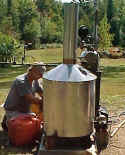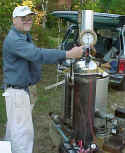 |
 |
NOTE: Modified/edited 5 Dec 2001(original tests of 2000
not found) for website publication.
Last year we wrote about the semi-successful tests done on 1 October 2000 and another article on what needed to be accomplished for this year’s tests. I am very happy to say that the modifications made to the boiler over last winter resulted in virtually flawless boiler operation from the burner on 20% of the time to a 15 minute run at 100% fire (We were burner limited to 3 gallons of kerosene per hour while the boiler is designed for 6 gallons per hour).
Last year the boiler cycled/primed when over
half the available burn rate, the Lamont circulating pump would deadhead under
certain conditions creating the 580-600 degree superheat to fall to wet steam
temperature of about 420 degrees. Several
changes were made that resolved the performance fluctuations.
Initially the output of the five layer spiral coil economizer and boiler
coil (Doble monotube type) dumped into the output of the 60 foot Lamont circuit
and created back pressure surges on the circulating pump output slowing or
stopping the forced circulation from occurring,
then all the water in the “Doble” section and the Lamont coil would be blown
into the vertical drum, raising the water level and creating enough turbulence
to have water thrown into the superheater. Under these conditions the amperage
of the 12 volt circulating pump motor would fluctuate from 8.5 to 4 amperes when
cavitation occurred and was unacceptable. We had some serious thinking to do,
one of which was to go from turning the feedwater pump on only when the drum
water level sensors called for water to a more temperature oriented control
system. However our first test
taught us much and considering that Rod and I were trying to take all the data
and pay attention to the gauges and thermocouples was more than we could fully
concentrate on.
During the winter Rod Teel made a separate
tangential entry for the boiler coil output to remove it from entering at the
Lamont coil output, he machined a new circulating pump impeller that I had
designed to increase the pressure output of the circulating pump, I believe a
picture of the circulating pump has been in a previous issue.
Rod also worked on his engine; he bored and sleeved it to change the
porting, made oil slingers to help lubricate the engine at high rotational
speeds, we designed new steel pistons of light weight with three rings to
replace the cast aluminum pistons of two rings(the low pressure aluminum piston
had signs of cracks and impending failure.
The conical pistons were coated with a ceramic thermal barrier and the
slide valves with a high temperature molybdenum low friction material. By the
way we had never run Rod’s beautiful engine on this boiler before but it had
been run up to 900+ rpm on Elroy Ekdahl’s boiler the previous year.
The second round of testing started early on 4 September 2001 but this
time we had two additional smart and able minded persons(not implying that Rod
or I have such qualities) to watch gauges and things and act as automatic
controllers, Rod and I thank Jim
and Helmut for their great help during this long day.
Jim unerringly watched two thermocouple meters and the drum water lever
and never faltered from controlling the feedwater pump switch, Helmut was in
control of the burner and pressure regulator adjustments and absolutely no smoke
was emitted after his attention.
This time the strategy was to not control
feedwater totally by the water level indicators but by one lower water level
indicator and the temperature coming out of the boiler coil—if it superheated
at all the feed pump would be turned on to put water into the Doble monotube
section. The water level indicator
system, the design provided by Craig Standbridge, performed flawlessly. Also flue gas temperature was watched and if it raised 100
degrees the feed pump would also be turned on.
It appears as long as the boiler coil output temperature was controlled
the flue gas temperature never fluctuated.
The four-hour test results, starting at 25%
fire to a 15 minute of full firing rate was most satisfying.
All the steam was being exhausted through a long copper 20 foot tube and
it slowly turned blue during the tests, it kept the noise away form us.
The engine was not connected during these tests.
We had two throttling valves, one at the entrance of the superheater and
one after it; I decided to use the second valve only to record the superheat
temperature at the full boiler pressure, somewhere between 290-320 psig.
This is all our pressure regulator allowed plus the safety valve would
blow at around 330psi.
TEST
RESULTS AT FULL 3 GALLON FIRE:
Superheat 600-620 degrees F. (180-200
degrees superheat)
Flue temperature
390-410 degrees F.
Boiler Efficiency 82.6%
Steam produced 257#/hr@ 3GPH firing rate.
Heat transfer per square foot heating
surface (35sq.ft.) 9,620 BTU/sq.ft./hr
Lamont pump amperage
6-7 amperes, about .09 horsepower
At no time did the abrupt opening or closing
of the throttle disrupt the boiler operation or lead to any kind of instability.
After all this testing, around 4PM, we took a short break and decided to
drag Rod’s engine out of the shop and connect it up to the boiler.
The
picture included speaks a thousand words, the engine was turning about 700rpm
and the fire was on about 20% of the time, the newness and tightness of the
engine was using about 50 pounds of steam per hour to run itself driving a
V-belt and generator plus a few other pulleys.
As the engine loosens up this will be much less, as mentioned it is very
tight right now and takes considerable effort to turn over by hand.
Another picture has the author pointing at a gauge reading 1200psi during
the hydrostatic testing done earlier.
We were all very happy with this success, may the next test at 4GPH kerosene be as successful, and we are making our own air-aspirated burner to try and get to 6 GPH kerosene for the final tests. At that rate this little 22 inch OD by 30 inch high boiler would certainly make a Stanley go very well, hopefully Rod can have it in his steamboat next year to approach the Lake Winnepesaukee steam speed record---he has much work ahead of him to get prepared, those of you that work on cars know how much work is involved with such projects, especially one-of-a-kind prototype systems. For automotive use the boiler would be used “upside down” with the firebox on top and flue on the bottom a la Doble---it makes no difference to the Lamont!!
Anyone
knowing where we could get an inexpensive 600psi pressure switch and safety
valve please respond in the "SteamGazette/Steam
Cars Forum".
George K. Nutz 5 Dec 2001